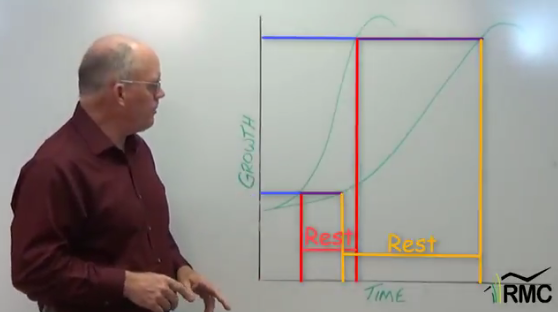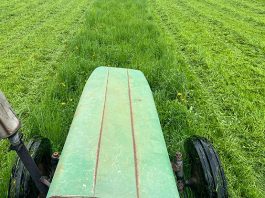Did you miss the start of this series? Here is Part 1, Part 2, and Part 3.
Bale grazing has been increasing in popularity for several years now. This method of feeding minimizes or eliminates the need for running any feeding equipment in the winter months, but is it really all sunshine and roses?
Let’s take a look at potential for excess nitrogen loading soils under bale grazing.
Spaced Bale Feeding
As part of our early efforts in the 1980s to reduce the cost of feeding hay, we developed what we called ‘Spaced-bale feeding’. This was an early version of bale grazing.

Bales were placed in a feeding block as shown on the right side of the picture. We only handled bales once as they were picked up from the field and put in a feeding block, usually in the same field. Spacing was generally 25-30 ft on centers. The bales were protected with an electric fence and then when it was time to feed, a line of bales was exposed and ring feeders placed on those bales. We manually flipped the feeders each time we fed hay.

We quickly noticed that while we were enriching the pasture fertility in the feeding area, we were having no effect on increasing P levels away from the feeding block. In fact, they were going down.
Yes, the spaced-bale feeding system allowed us to reduce cost of feeding in the winter but it was mining nutrients from the pasture as a whole and concentrating them around the feeding block. We did relocate the block every year, but they were always placed close to the permanent fence and not scattered all across the pastures.
Bale Grazing

Bale grazing was being done more commonly in Canada by the early 2000s. Ring feeders were done away with because of the difficulty using them in deep snow situations.
An electric fence is moved and a set number of bales were exposed to the cattle. Very often the bales were just left where the baler had dropped them in the summer, so equipment cost was reduced even further.
As more producers bought their needed hay rather than baling it themselves, bale grazing started to trend back towards feeding blocks rather than widely scattered bales across the field where they had been harvested.
Now we can look at the N being returned to the field in those feeding areas using the information shown earlier in this series of posts.

That is a lot of N!
You might ask, “But who would feed 20 tons/acre?”
Here is an aerial photo showing where bale grazing took place on a farm the previous winter. We easily see the increased growth where the bales had been fed. The area outlined is one acre.

With 36 bales weighing 1300 lbs fed on that one acre, the urinary N returned is over 400 lbs/acre!
Even if the cows did wander off and urinate in different parts of the pasture, there is likely still at least 300 lbs/acre raining down on the feeding block.
This is where we can end up when we don’t have a feeding plan that balances the feeding rate with the capacity of the soil to absorb and hold N.

In some parts of the US such as the Chesapeake Bay and Great Lakes watersheds, N overload is a serious issue and regulations are in place to regulate manure application and animal concentration.
It is in everyone’s best interest that we on the land understand the consequences of our decisions. We all need to have nutrient management plans for our farms and ranches – not because the government is going to eventually make all of us do it, but because it makes economic and environmental sense to do so.
Nitrogen is only part of the fertility story. Next week, we’ll look at Phosphorus.





Reading this article I get the impression that you are suggesting bales should be rolled out rather than placed out ahead of time for planned bale grazing. If this is what is being suggested, I would like to point out the cost of rolling out bales. Seventeen years ago I was feeding 200 dry cows rolling out bale with horses. A friend using a pickup with a roller kept telling me that his method was very inexpensive. When we did a comparison, yardage when feeding with horses cost $0.25/hd/day, his method cost $0.35/hd/day, and planned bale grazing cost $0.10/hd/day. Based on 200 head, planned bale grazing saved $30 & $50/day respectively. Yes nutrients are concentrated, however, to be a low cost producer, all expenses must be considered.
Hi Tom,
Yes, unrolling hay will cost more than bale grazing.
If bale grazing is done at an appropriate number of bales per acre to not overload the soil with N, the result is islands of nutrient enrichment with higher productivity than the surrounding areas.
What is the difference in total yield the subsequent year(s) after the hay was fed depending on whether it was unrolled or bale grazed?
Depends on the environment. I do not know of research making that comparison.
Anecdotally, I have heard ranchers claim anywhere from no difference to 50 more AUD/acre when the hay was spread out more uniformly. I suspect the person who said there was no difference has no actual measurement to verify that claim. The individual claiming 50 AUD/acre more has records showing that difference. He is convinced there is an advantage to unrolling hay compared to bale grazing.
Using the figure of an AUD value of $.58 from your article today, that would be $29 more income per acre from unrolling the hay.
Was your comparison of yardage cost in US on CAN $?
Jim
Let me provide an example of how much bale grazing improved a paddock (it would be great to have research that compared rolling out vs bale grazing):
in 2017 an 11acre paddock provided 49SDA of forage. A herd of 350 dry cows was bale grazed in the paddock the winter of 2017-18. During the summer of 2018, that same paddock provided 194SDA of forage, for an increase of 145SDA. Using $0.58/SD, that equates to an increase of $84/ac (CDN$ lol). I have not seen that kind of improvement rolling out bales, however, my experience is limited.
At what hay price point does bale grazing become viable? Local hay prices are $150-200/ton, and the $150 needs protein supplement.
I’ve done bale grazing when hay was inexpensive, would be costly venture this winter.
Hi Gene,
That is a tough question.
What is the product value of critters eating that hay?
Where is the cattle market today?
How much wastage is occurring in the bale grazing? That depends on frequency of feeding.
Another reason I prefer unrolling is you can much more tightly control wastage compared tobale grazing.
Jim
Comments are closed.